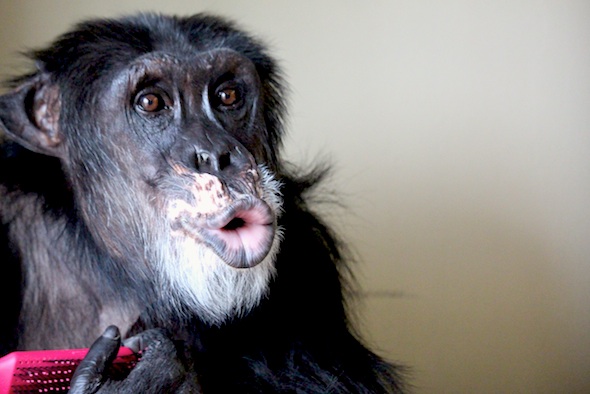At Chimpanzee Sanctuary Northwest, we encourage all of our staff and volunteers to communicate with the chimps in their language as much as possible. This means that we adopt a submissive posture when the chimps are displaying, we cover our top teeth when we smile during play, and we pant hoot with the group when they are excited.
This last one can be difficult, though. Pant hoots, like many other chimp vocalizations such as breathy-pant greetings and laughter, require rapid breathing – as much as 10 to 15 times the normal rate. One minute you’re singing along with the chimps, the next minute you’re passed out on the floor. How do the chimps get away with it?
One interesting theory involves laryngeal air sacs, which are inflatable extensions of the vocal tract in the neck and upper chest of chimps and many other primates. I worked with chimps for a while without even realizing that they had air sacs, and they only came to my attention because they are prone to infection (airsacculitis) and occasionally need to be treated. They’re not noticeable in chimpanzees under normal circumstances like they are in some other species. Interestingly, humans and a few other primates lack them altogether.
So what function do they serve? No one really knows for sure. The most obvious answer would be that they make vocalizations more efficient, possibly by increasing amplitude, matching impedance with the surrounding air, or lowering their frequency so that they travel farther through forest environments. But this doesn’t seem to be true in all species. Alternatively, they may allow smaller primates to sound larger than they are for the purposes of mating or territoriality – much like the way that male dogs attempt to urinate as high on a tree as possible. Whereas dogs tag trees to say WATCH OUT – VERY BIG DOG WAS HERE, perhaps monkeys are saying BEWARE – YOU ARE ENTERING GIANT MONKEY TERRITORY. But again, the evidence is mixed.
Air sacs are thought to be associated with a few species-specific calls such as the siamang’s “ascending boom” and what is perhaps the best named primate vocalization of all time, the gorilla’s “sex whinny”.
My favorite theory – which does not make it true, by any means – is that these air sacs allow certain primates to produce rapid inhale-exhale calls without hyperventilating. The sacs expand during exhalation, which means that they fill with CO2-rich air, and then they collapse during inhalation. What do humans often do when we are hyperventilating? We breath into paper bags to rebreathe our own air and restore CO2 levels (don’t try this at home on my advice, as it appears some more serious conditions can be mistaken for hyperventilation and made worse by rebreathing). Chimps, it turns out, have the equivalent of paper bags built right in.
Air sacs may very well serve different functions in different species, or even multiple functions within the same species. The above theories aren’t mutually exclusive. But it’s clear that humans get along just fine without them – well, humans that don’t work with chimps, that is. Our ancestors most likely possessed them, so why would they disappear? It’s possible that when humans evolved ways to modulate our breathing and produce multiple phrases with each exhale we lost the need for them, and because they are prone to infection, they eventually disappeared.
Which means that we humans have to temper our excitement around the chimp house or else we’ll end up passing out before the party has even started.







